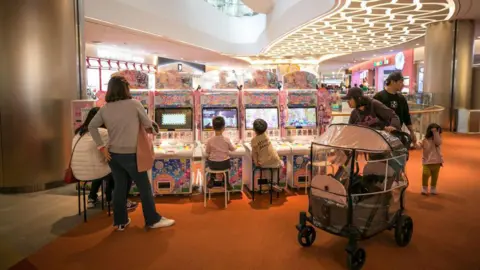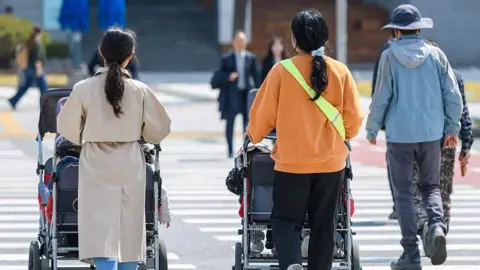BBC News
 Jang Sae-ryeon
Jang Sae-ryeonWhen she started in vitro fertilisation (IVF) last November, Kim Mi-ae knew it would be a gruelling test of patience – something she had already endured when she conceived her first child three years ago.
But what shocked her this time around were the “crazy” waits at the fertility clinic.
“When I went in January, it felt like everyone had made a New Year’s resolution to have a baby! Even with a reservation, I waited over three hours,” says the 36-year-old Seoul resident.
While South Korea continues to struggle with the world’s lowest birth rates, fertility clinics are in growing demand – a bright spot in the country’s demographic crisis.
Between 2018 and 2022, the number of fertility treatments carried out in the country rose nearly 50% to 200,000. Last year, one in six babies in Seoul were born with the help of fertility treatment.
Underpinning the boom, experts say, is a shift in attitudes about family planning.
“We have a young generation… that is used to being in control of its life,” says Sarah Harper CBE, professor in Gerontology at the University of Oxford. That control, she adds, may come in the form of single women freezing their eggs or couples trying IVF when they can’t conceive.
“Whereas in previous generations there was a greater acceptance that whether you conceive or not can be a bit haphazard, now we have Korean women saying, ‘I want to plan my life.'”
This is good news for South Korea’s government, which is trying to lift the country out of a demographic crisis. One in five people in South Korea are now aged 65 or above. As a proportion of the country’s total population, there have never been fewer babies.
 Getty Images
Getty ImagesThe country has repeatedly broken its own record for having the world’s lowest birth rate: 0.98 babies per woman in 2018, 0.84 in 2020 and 0.72 in 2023. If this trend continues, experts warn the population of 50 million could halve in 60 years.
But recently there is reason for cautious optimism: instead of another record low, South Korea’s birth rate rose slightly to 0.75 in 2024 – its first increase in nine years.
“It’s a small bump, but still a meaningful one,” says Seulki Choi, a professor at the Korea Development Institute’s School of Public Policy and Management.
It is too early to tell whether this is the start of a much-needed reversal or just a blip. The country’s birth rate remains far below the global average of 2.2. But many like Dr Choi are cautiously optimistic.
“If this trend holds, it could signal a longer-term shift,” says Dr Choi. “We need to watch how young people’s attitudes toward marriage and parenthood are changing.”
For years, having children was the last thing on Park Soo-in’s mind. She was mostly busy at work, often only clocking off from her advertising job at 04:00.
“I was in a company with endless overtime, so it wasn’t even something I could realistically consider,” says the 35-year-old.
Things started to change after she got married two years ago. She landed a new job with better hours – and friends around her started having babies.
“Seeing and interacting with their kids made it feel less overwhelming,” she said. “And watching my husband take initiative, doing research on pregnancy and childbirth and showing real effort, gave me confidence that we could do this.”
 Getty Images
Getty ImagesWhen Ms Park and her husband had trouble conceiving, they looked to fertility treatments. Many others are doing the same, fuelling projections that the burgeoning industry could be worth more than $2bn by 2030.
“This is actually an important signal for policymakers that there are still some women who want to start families but are facing … barriers to doing so,” says Jennifer Sciubba, president and CEO of the non-profit Population Reference Bureau in Washington, DC.
“More than anything, this is a sign that people are unable to fulfil their desires to have children.”
Difficulty conceiving is just one barrier. At the heart of South Korea’s population woes are a raft of social and financial pressures – from patriarchal norms that place most childcare responsibilities on women to long work hours and high education costs – which discourage many young people from having children.
For some, however, those dreams have merely been delayed. More than half of South Koreans say they want kids but can’t afford them, according to a UN report. And by the time South Korean women have their first child, their average age is 33.6 – among the highest in the world.
“Looking back, it might have been better to start earlier,” says Ms Park. “But realistically… now actually feels like the right time. In my late 20s, I just didn’t have the financial capacity to think about marriage or kids.”
The same goes for Ms Kim, who spent three years saving up for marriage and another four for a child.
“People spend their youth studying, job hunting, and spending money to prepare for life. And by the time they’re ready to settle down, it’s often late,” she says. “But the later you wait, the harder it gets [to become pregnant], physically and emotionally.”
For those who opt for IVF, the process of trying to conceive also becomes much more expensive.
“It’s hard to say exactly how much IVF costs because it varies so much by person and cycle,” says Ms Kim. “It’s a huge and unpredictable expense that can really affect your finances.”
 Jang Sae-ryeon
Jang Sae-ryeonAs part of concerted efforts to boost its birth rate, South Korea’s government has expanded its support for fertility treatments. Seoul now subsidises up to 2 million Korean won ($1,460; £1,100) for egg-freezing and 1.1 million won for each IVF treatment.
But even with government subsidies, Ms Kim says she spent more than 2 million won in January for IVF – mostly on out-of-pocket items that subsidies do not cover, such as supplements and additional tests.
And with less than half of IVF cycles ending in success, the costs can stack up quickly.
This has been the case for Jang Sae-ryeon in the southwestern Jeolla province. The 37-year-old started fertility treatment two years ago and has done five IVF cycles, each of which cost her around 1.5 million won.
“I wish things worked out after just one or two tries, but for most people, that’s not the case,” she says. “Without money, you simply can’t move forward. That’s the reality. And I think that’s the most frustrating part.”
Equally challenging, women say, are the workplace pressures they face when they commit to a demanding IVF schedule.
While South Korean companies offer several days of leave for fertility treatment, women say that in reality it is difficult to utilise them. Ms Kim says she underwent IVF for her first child without taking leave at all. Ms Jang, meanwhile, says her colleagues asked her to postpone her treatment.
“It made me feel like IVF and a full-time job just don’t mix,” says Ms Jang. “So I quit. But once I left, I struggled financially. That led to another cycle of quitting and job-hunting again.”
Such financial and cultural pressures may have dampened many South Koreans’ dreams of having children, but not Ms Jang’s. She still gets teary when she recalls two pregnancies from early in her marriage – both of which ended in miscarriages.
“You know how they say when you have a child, you feel a love that’s limitless?” she says. “I think having a child that resembles both of us and creating a family together is one of the greatest forms of happiness a person can feel.”





